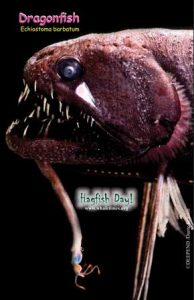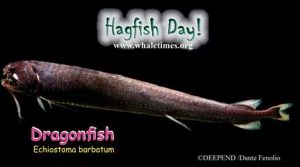Hey Hagfish Day Fans,
 We had to go to the DEEPEND to find our next expert. Dr. Tracey T. Sutton is an Associate Professor at Guy Harvey Oceanographic Center, Halmos College of Natural Sciences and Oceanography at Nova Southeastern University. He is also the Director, PI, and fearless leader for the DEEPEND: Deep Pelagic Nekton Dynamics Consortium.
We had to go to the DEEPEND to find our next expert. Dr. Tracey T. Sutton is an Associate Professor at Guy Harvey Oceanographic Center, Halmos College of Natural Sciences and Oceanography at Nova Southeastern University. He is also the Director, PI, and fearless leader for the DEEPEND: Deep Pelagic Nekton Dynamics Consortium.
What was your first thought when you heard that hagfish finally got their own holiday?
- TS: I think this is fantastic! Hagfish are truly amazing – they are among the most ancient animals on earth, and actually predate dinosaurs (by a LOT).
What makes a dragonfish standout and make it a Hagfish Day Star?
- TS: Though they are poorly known, these are the world’s most abundant top predators due to the immense size of the deep, dark ocean interior. Their predation controls the abundances of smaller fishes that eat plankton, such as lanternfishes, which then control the amount of carbon the ocean can take up (and hence combat global climate change).Also, as a predator, these fishes are amazing. Their meals (usually another fish) may often weigh as much as they do. That would be like a person eating 300 Big Macs in one meal!
Why is it called a dragonfish?
- TS: I believe it is because of the fearsome teeth – most of these fishes have mouths jam-packed with long, sharp, needle-like fangs.
 I saw a dragonfish once. It had something weird on its chin. Is it a messy eater or is that something else?
I saw a dragonfish once. It had something weird on its chin. Is it a messy eater or is that something else?
- TS: That was something on its chin (dragonfishes swallow their prey whole, like a snake, so are in fact very neat eaters J). The thing on their chin as a structure called a barbel, which is a slender filament that contains a glowing “lure” on the end. Dragonfishes use their barbel to bring prey close enough to eat. The thought is the fishes that dragonfishes eat confuse the lure with the plankton upon which they feed.
These barbels come in an amazing variety of shapes and colors.
With those huge teeth, could it eat a whale shark?
- TS: I’n afraid not – a large dragonfish may be 2 feet long, whereas a large whale shark may grow to 41 feet long and weigh 21 tons.
How does increased and larger scale fishing deeper in the ocean impact deep-sea animals like the dragonfish and hagfish?
- TS: The main issue here is that we do not know how many dragonfish are out there, so we would not be able to determine the impact of fishing on their abundances. What we do know is that food webs in the deep sea are very tight – the abundances of predators follows that of their prey closely. Removing parts of the food web via fishing would likely have a large effect on the rest of the ecosystem. We have seen this already with overfishing of sharks – we estimate that shark populations now are less than 10% of their “normal” numbers.
How long have you been studying deep-sea fish, like the dragonfish? Do you study them from shore, a ship, a sub?
- TS: I have been studying these fishes for about 25 years. Most of my work is done in a laboratory – I examine fishes in great detail after I have collected them during research expeditions.
What are you studying now?
- TS: Right now my biggest project is trying to determine the effect of the Deepwater Horizon oil spill on the deep-sea life in the Gulf of Mexico. Projects involved with this research include food web studies (who eats whom), description of new species, and determining population sizes over time since the spill.
What is the goal or how will this research help dragonfish and/or other ocean animals?
- TS: The human need for energy has pushed us to exploit even the deepest reaches of the sea, even before we know what damage our activity may cause. Our project will help shed light on what can happen when things go terribly wrong (like the oil spill disaster).
How can I help protect black dragonfish?
- TS: By being aware of what is happening in the open ocean, and supporting efforts to protect our seas. Get involved with efforts by our federal government (i.e., your senator and local representative) and tell them that the ocean belongs to all of us, and that you support efforts to manage it wisely.

Why is a dragonfish cooler than a great white shark or dolphin?
- TS: A dragonfish’s meal, relative to its own size, may be more than four times larger than that of a white sharks, and much more than that of a dolphin. In addition, dragonfishes can make light, much like a firefly, something neither a great white or a dolphin can do.
What do you want/hope kids to learn/discover while they celebrate Hagfish Day?
- TS: That there is an AMAZING variety of life in the deep sea, and that the creatures there would put those in any Harry Potter book to shame!
How can I support (and/or follow) your research?
- TS: You can follow our research at these websites:
- Lab website: http://sutton.deependconsortium.org/
- DEEPEND website: www.deependconsortium.org